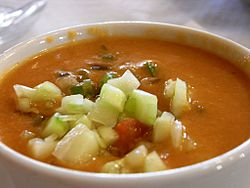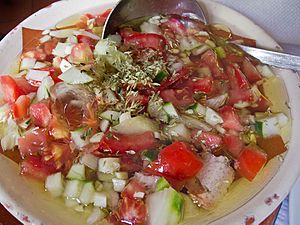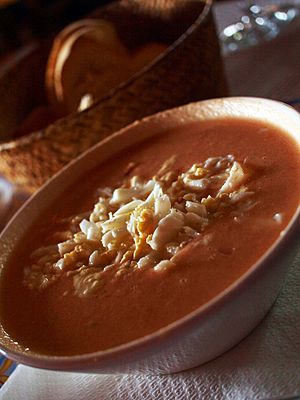Gazpacho facts for kids

Gazpacho
|
|
| Alternative names | Andalusian gazpacho, Gaspacho |
|---|---|
| Course | Appetizer |
| Region or state | Andalusia, Alentejo, Algarve |
| Serving temperature | Cold |
| Main ingredients | Bread, olive oil, vinegar, garlic, tomato, cucumber |
| Variations | Salmorejo, ajoblanco |
| variable kcal | |
Gazpacho (say "gahz-PAH-choh") is a yummy cold soup. It's made from raw, blended vegetables. People also call it Gaspacho or Andalusian gazpacho.
This refreshing soup first came from the southern parts of the Iberian Peninsula (which is where Spain and Portugal are). It's very popular in Spain and Portugal. People especially love to eat it during hot summers because it's so cool and refreshing!
Even though there are other recipes called gazpacho, like gazpacho manchego, most people think of the tomato soup version when they hear the name. There are also other similar cold soups. These include ajoblanco, salmorejo, and porra antequerana.
Contents
History of Gazpacho
Many people wonder where gazpacho came from. One idea is that it was a simple soup of bread, olive oil, water, vinegar, and garlic. This soup might have arrived in Spain with the Romans.
Once in Spain, it became a common food in the southern areas. Places like Córdoba, Seville, and Granada made it with stale bread, garlic, olive oil, salt, and vinegar. This early version was a bit like ajoblanco.
During the 1800s, something exciting happened: tomatoes were added! This made the gazpacho red. This new, red version became famous around the world. It's the one most people know today.
Today, there are many new kinds of gazpacho. Some use avocados, cucumbers, parsley, or even strawberries. Others might have watermelon, grapes, or seafood. These modern versions use different ingredients instead of just tomatoes and bread.
Ingredients and How to Make It
Most gazpacho recipes use a few main ingredients. These include stale bread, tomatoes, cucumbers, onion, bell peppers, garlic, olive oil, wine vinegar, water, and salt. Some recipes from northern Spain also add cumin or pimentón (which is smoked sweet paprika).
Traditional Preparation Methods
In the past, people made gazpacho by crushing vegetables in a mortar with a pestle. This way took more effort, but it helped keep the gazpacho cool. It also made the soup smooth without creating foam, which blenders sometimes do.
A traditional way to make it is to crush garlic cloves in a mortar first. Then, you add a little stale bread that has been soaked in water. Next, you mix in olive oil and salt to make a paste. Finally, very ripe tomatoes and vinegar are added to this paste.
Before refrigerators, gazpacho was kept in a special clay pot. This pot would cool the soup as water slowly evaporated from its surface.
Serving Gazpacho
Gazpacho can be enjoyed on its own. But it's also often served with different toppings. Some popular garnishes include hard-boiled eggs, chopped ham, chopped almonds, or orange slices. You can also add finely chopped green bell pepper, onion, tomato, or cucumber.
In a region called Extremadura, people sometimes add local ham right into the gazpacho itself. This is called gazpacho extremeño. People in Andalusia say gazpacho should be slightly chilled, but not super cold or icy.
Different Kinds of Gazpacho
The ingredients, how thick it is, and its texture can change a lot. This depends on the region and even on different families' recipes.
Similar Cold Soups
Other cold, raw soups are also popular in Andalusia. These include arjamolho from Portugal, porra antequerana, and ajoblanco. They are similar to gazpacho but not as widely known.
Salmorejo is very much like gazpacho. Both are cold soups made with tomatoes and are popular in Spain. The main difference is how they are made. Gazpacho is a soup, while salmorejo is more like a thick sauce or emulsion. Also, gazpacho can have cucumber, peppers, and vinegar, but salmorejo usually does not.
Hot Gazpacho?
You might hear of Gazpacho manchego. Despite its name, this is not a cold vegetable soup. It's actually a hot meat stew!
Gazpacho Varieties in Spain
The very first gazpacho recipe used bread, water, vinegar, oil, and salt. This recipe is traditional across the Iberian Peninsula, possibly from Roman times. Each central and southern region of Spain has its own special version.
This simple gazpacho became a very important food for peasants and shepherds in Spain. The basic recipe led to many different kinds of gazpacho. Some authors have even tried to sort all these variations.
Gazpachos can be grouped by their color:
- Red ones are the most common and have tomatoes.
- White ones don't have tomatoes but might include dried fruits.
- Green ones are white gazpachos with certain spices that make them green.
All these types share some basic ingredients. They all have garlic paste (which helps mix everything together), bread, olive oil, vinegar, and salt. Sometimes, red fruits like strawberries or muskmelon are added to make the gazpacho a bit sweeter. You can eat gazpacho as a starter, a main meal, or a small tapa.
Arranque Roteño
A popular type comes from the town of Rota in the province of Cadiz. In times when there wasn't much water, people couldn't make regular gazpacho. So, arranque uses the same ingredients but needs less water and bread. This makes it more like a thick cream. Some people add even more bread to make it like a dip.
Extremaduran Gazpacho
In Extremadura, gazpachos are often thick purées. They are known as cojondongo or cojondongo del gañán. These are made from breadcrumbs, garlic, oil, and vinegar. They are then topped with chopped onions, tomatoes, and peppers.
La Mancha Gazpacho
Gazpacho manchego, as its name suggests, is made in the eastern region of La Mancha. It's popular in Albacete and nearby areas, as well as other parts of central and southwest Spain.
This is a meat stew. Its main ingredients are small game animals or birds. These can include rabbit, hare, quail, or pigeon. It also uses flat bread and might have garlic, tomatoes, and mushrooms. It's cooked in a big pot and served hot. Another well-known type in La Mancha is gazpacho de pastor or galiano.
Some other hot meat or fish dishes from different regions are also called gazpacho. Examples include gazpacho jumillano and gazpacho de Yecla.
Castilian Gazpacho
Gazpacho is often eaten during the very hot and dry summers in Castilla y León. The gazpacho made in La Moraña in the Ávila province has large pieces of vegetables floating in a watery soup.
See also
 In Spanish: Gazpacho para niños
In Spanish: Gazpacho para niños



